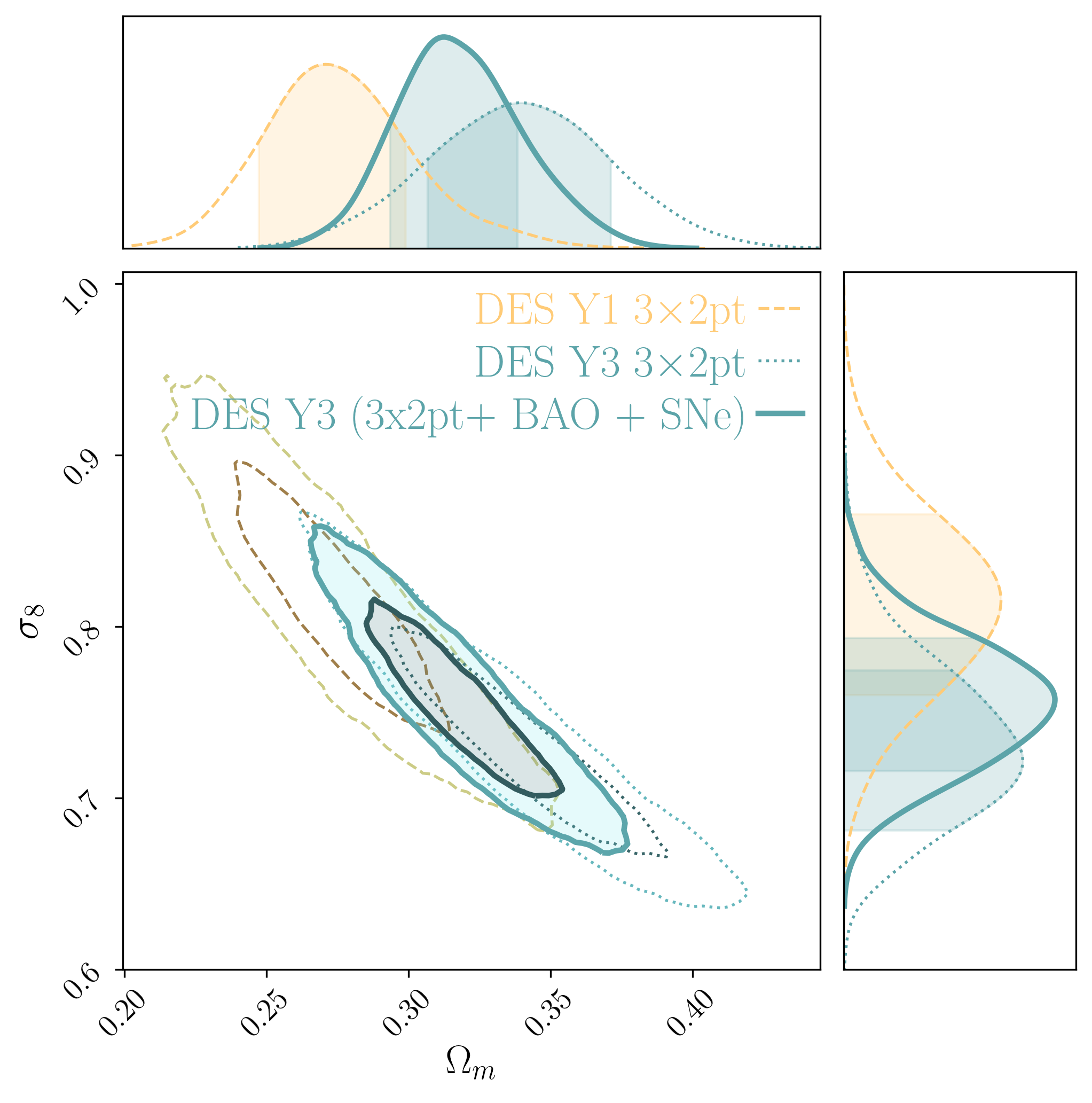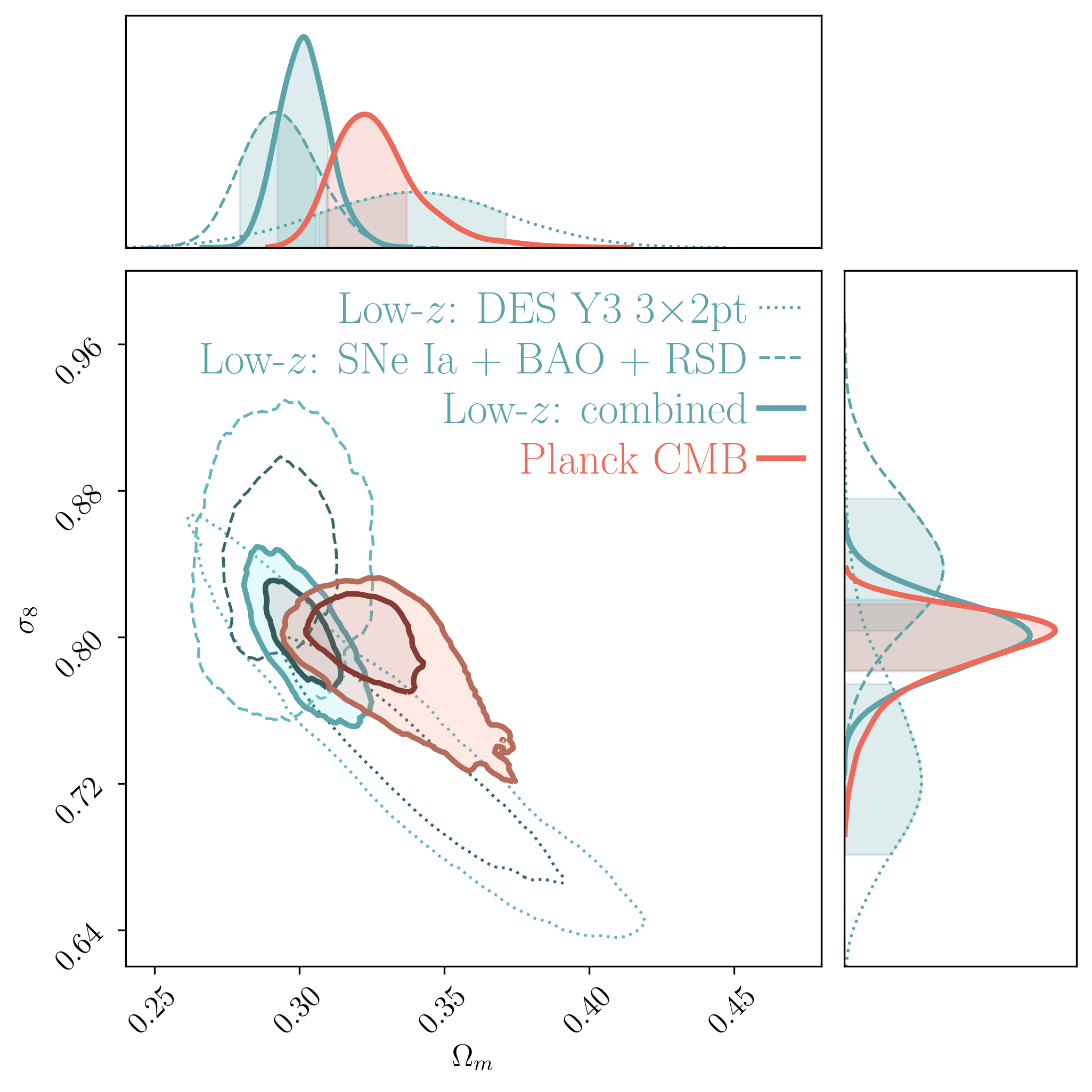Cosmology from galaxy surveys
Data analysis with current surveys
A major part of my research has consisted of extracting cosmological information from large-scale structure and weak gravitational lensing measurements. In particular I have used observations from the Dark Energy Survey (DES), a photometric galaxy survey that covers ~5000 sq. deg. of the southern sky and has measured the positions and shapes of over one hundred million galaxies. Specifically, I have been part of the core team that has performed a so-called 3×2pt analysis, which stands for the combination of three two point correlation functions: one from position-position correlations (galaxy clustering), one from shear-shear correlations (cosmic shear), and one from position-shear correlations (galaxy-galaxy lensing). Since 2021, as Co-Convener of the DES Weak Lensing Working Group, I am helping to coordinate the flagship analysis of the full six-year dataset.
I recently wrote a review that summarizes the current state of weak lensing cosmology—I tried to make it accessible as a first entry point for students or researchers who are interested in the field. Here you can also find some of the main results from the DES Y3 3×2pt analysis:
Dark Energy Survey Year 3 Results: Cosmological Constraints from Galaxy Clustering and Weak Lensing.
Preparation for future surveys
Besides this, I'm also a member of the Dark Energy Science Collaboration (DESC) within the Vera Rubin Observatory's Legacy Survey of Space and Time, where I'm developing and validating the pipelines that will be used when the data arrives. I led the development of TXPipe, a modular pipeline for generating robust data vectors in cosmology analyses for the LSST. In the publication below we present the software, which is public for everyone:
The catalog-to-cosmology framework for weak lensing and galaxy clustering for LSST.
Expanding frontiers
Gravitational Lensing Ratios: A Clean Geometrical Probe
Developing new ways to test cosmology
A big focus of my research is working on gravitational lensing ratios as probes for cosmology. The idea is the following: by taking ratios of different lensing measurements (like galaxy-CMB lensing compared to galaxy-galaxy lensing), we get something that depends purely on geometry—specifically, angular diameter distances. This means we don't have to worry as much about all the messy astrophysics (like galaxy bias and the matter power spectrum), and we can even use data from smaller scales that we'd normally have to throw away because the astrophysics is too uncertain.
Together with close collaborators, we have made the first to make these measurements work with photometric data. My work includes both CMB lensing ratios (Prat et al. 2019) and galaxy-galaxy lensing ratios (Prat et al. 2018; Sánchez, Prat et al. 2022). It's been really cool to see other collaborations like KiDS, HSC, and DESI adopt these techniques.
What makes lensing ratios especially interesting is that they are particularly sensitive to spatial curvature and dark energy evolution, and they constrain different parameter combinations than standard probes like baryon acoustic oscillations. With next-generation data from LSST and Simons Observatory coming soon, we'll be able to make much more precise measurements and really test whether dark energy is evolving over time.
To the small-scale regime
Learning about the galaxy-matter connection and developing mitigation schemes
Extracting useful cosmological information from small scale two-point measurements is tricky because of non-linearities and baryonic effects. To deal with these complications, cosmological analyses often just discard scales below a certain threshold—for instance, we had to throw out ~50% of the signal-to-noise in the DES Y3 3×2pt analysis! So one of the biggest gains we could make for future analyses would be figuring out how to reliably use smaller scales.
I have been working on this from a few different angles. I have been part of efforts to better understand the galaxy-halo connection from galaxy-galaxy lensing and we have measured the stellar-to-halo mass relation (SHMR) using a new stellar mass sample we developed for DES Y3 (which you can find publicly available here). I have also published a comparison of methods to deal with some of the complications from small scales. I led the galaxy-galaxy lensing measurements for DES Y1 and Y3 (Prat et al. 2018, 2022), which involved developing and validating methods to extract the cleanest possible measurements.
More recently, I have been exploring measurements in regimes where we haven't looked much before. For example, together with the undergraduate student Nathalie Chicoine at UChicago (which now is a graduate student at the University of Pittsburg), we made the first detection of lensing signals around low surface brightness galaxies (Chicoine, Prat et al. 2024).
To the higher-order regime
Simulation based inference applied to weak lensing mass maps
The early Universe was very Gaussian, so two-point statistics (like the correlations we measure in 3×2pt) capture most of the information. But the late-time Universe is non-Gaussian, which means there is a lot more information hiding in higher-order statistics. The problem is that these are computationally expensive and hard to model with traditional methods, so most analyses still focus on two-point statistics.
During my time as a Schmidt AI in Science Fellow, I worked on using machine learning to get at this extra information. This led to publishing a persistent homology analysis (a technique from topological data analysis) with DES Y3 weak lensing mass maps, using simulation-based inference. This methodology yields constraints that are 70% tighter than those obtained through traditional cosmic shear two-point analysis.
To the large-scale regime
Combining Galaxy Surveys and Gravitational Wave Observatories
On very large scales, optical surveys face some challenges: systematic errors from selection effects, and limited statistical power because of finite sky coverage. Interestingly, gravitational wave (GW) sources seem to be less affected by these issues. We have been exploring how much we could gain by combining LSST 3×2pt with large-scale measurements from next-generation GW experiments.
List of publications
To follow my latest papers, check the following ADS libraries:
All my papers.
Corresponding author papers.








